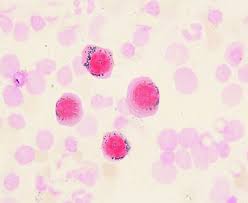
 Subtype of myelodysplastic syndrome with iron accumulation in red blood cell precursor mitochondria.
Subtype of myelodysplastic syndrome with iron accumulation in red blood cell precursor mitochondria.
Refractory anemia with ring sideroblasts is a type of myelodysplastic syndrome.
RARS is characterized by 5% or less myeloblasts in bone marrow. RARS is distinguished from refractory anemia by having 15% or more ringed sideroblasts among the erythroid precursors in the bone marrow.
Refractory anemia with ringed sideroblasts in transformation-10-30% of cases, 21-30% blasts, 50-60% transformation to AML.
Recurrent mutation of the SF3B1 gene is found in 20% of patients with myelodysplastic syndromes.
SF3B1 gene mutations are found in 65% of patients with ring sideroblastic anemias, and even among other subtypes of myelodysplastic syndromes with large numbers of ring sideroblasts in the marrow, such a gene mutation frequency is common.
SF3B1 mutations related to subtype refractory anemia with ringed sideroblasts, associated with improved prognosis.
Refractory anemia with the ring sideroblasts generally have a benign clinical course (Malcovati L et al).
Patients with refractory anemia and refractory anemia with ringed sideroblasts have a low risk for progression to acute myeloid leukemia.
More than 25% of cases have large numbers of ring sideroblasts in the bone marrow.
Ring sideroblasts usually seen on iron staining of marrow aspirate erythrocytes with a complete or partial ring of iron laden mitochondria surrounding the nucleus.
Patients with refractory anemia and refractory anemia with ringed sideroblasts have anemia as a result of ineffective erythropoiesis and high rate of erythroid apoptosis.
